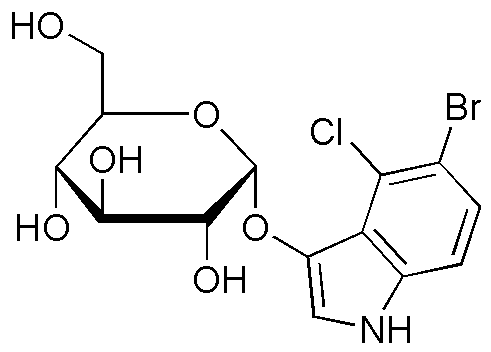5-Bromo-4-chloro-3-indolyl-a-D-glucopyranoside is widely utilized in research focused on:
- Biochemical Assays: This compound serves as a substrate in various enzymatic assays, particularly for studying glycosidases, which are crucial in carbohydrate metabolism research.
- Plant Research: It is used to investigate gene expression and enzyme activity in plants, helping researchers understand metabolic pathways and plant responses to environmental stress.
- Pharmaceutical Development: The compound is valuable in drug discovery processes, particularly in screening for potential inhibitors or modulators of specific biological targets.
- Food Industry: It can be applied in food science to study the effects of glycosylation on flavor compounds, enhancing flavor profiles in food products.
- Diagnostics: This chemical is utilized in developing diagnostic tools for detecting specific enzymes related to diseases, offering potential for early diagnosis and treatment strategies.
General Information
Properties
Safety and Regulations
Applications
5-Bromo-4-chloro-3-indolyl-a-D-glucopyranoside is widely utilized in research focused on:
- Biochemical Assays: This compound serves as a substrate in various enzymatic assays, particularly for studying glycosidases, which are crucial in carbohydrate metabolism research.
- Plant Research: It is used to investigate gene expression and enzyme activity in plants, helping researchers understand metabolic pathways and plant responses to environmental stress.
- Pharmaceutical Development: The compound is valuable in drug discovery processes, particularly in screening for potential inhibitors or modulators of specific biological targets.
- Food Industry: It can be applied in food science to study the effects of glycosylation on flavor compounds, enhancing flavor profiles in food products.
- Diagnostics: This chemical is utilized in developing diagnostic tools for detecting specific enzymes related to diseases, offering potential for early diagnosis and treatment strategies.
Documents
Safety Data Sheets (SDS)
The SDS provides comprehensive safety information on handling, storage, and disposal of the product.
Product Specification (PS)
The PS provides a comprehensive breakdown of the product’s properties, including chemical composition, physical state, purity, and storage requirements. It also details acceptable quality ranges and the product's intended applications.
Certificates of Analysis (COA)
Search for Certificates of Analysis (COA) by entering the products Lot Number. Lot and Batch Numbers can be found on a product’s label following the words ‘Lot’ or ‘Batch’.
*Catalog Number
*Lot Number
Certificates Of Origin (COO)
This COO confirms the country where the product was manufactured, and also details the materials and components used in it and whether it is derived from natural, synthetic, or other specific sources. This certificate may be required for customs, trade, and regulatory compliance.
*Catalog Number
*Lot Number
Safety Data Sheets (SDS)
The SDS provides comprehensive safety information on handling, storage, and disposal of the product.
DownloadProduct Specification (PS)
The PS provides a comprehensive breakdown of the product’s properties, including chemical composition, physical state, purity, and storage requirements. It also details acceptable quality ranges and the product's intended applications.
DownloadCertificates of Analysis (COA)
Search for Certificates of Analysis (COA) by entering the products Lot Number. Lot and Batch Numbers can be found on a product’s label following the words ‘Lot’ or ‘Batch’.
*Catalog Number
*Lot Number
Certificates Of Origin (COO)
This COO confirms the country where the product was manufactured, and also details the materials and components used in it and whether it is derived from natural, synthetic, or other specific sources. This certificate may be required for customs, trade, and regulatory compliance.


